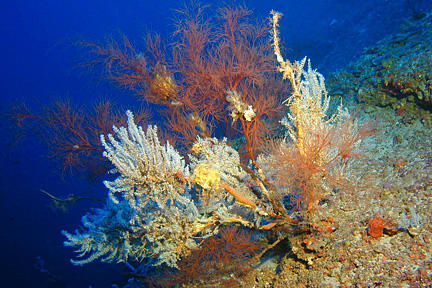
|
Coral study plan
called too timid
A federal agency stops short
of safeguarding the deep-sea
creatures
The National Oceanic and Atmospheric Administration announced a plan last week to develop a strategy for the study and protection of the nation's deep-ocean corals and sponges.
But the environmental group that submitted the petition that prompted the agency's decision, Washington-based Oceana, said the announcement did not go far enough to save the little-understood marine creatures.
Until the last decade, there was scant scientific information on the corals and sponges that live 100 to 2,000 meters below the ocean's surface, said Tom Hourigan, manager of the National Marine Fisheries Service's corals program.
"Because of their depth, we weren't really aware until recently of the number of these habitats and the great diversity and importance of them," Hourigan said.
Researchers are starting to find that the deep-ocean reefs -- similar to their warm-water relatives -- host rich, biologically diverse habitats, he said.
The existence of the corals was first brought to the attention of researchers by deep-sea fishing trawlers, which swept up the creatures in their gear. Dredges and trawls dragging along the ocean floor are now the biggest threat to the corals' survival.
Hawaii is also home to the corals and one of the only places in the nation where precious varieties such as black, pink and gold coral are harvested, Hourigan said.
Last month, the Western Pacific Fishery Management Council rejected a recommendation from its Scientific and Statistical Committee to temporarily ban the harvesting of black coral. The council instead decided to restrict the collection of the Hawaii state gem to older trees.
As part of its plan, NOAA will continue a current project to map the corals' habitats and issue a status report on the deep-sea coral communities within U.S. waters by the end of the year. Using that report, the agency will then move forward on developing a strategy for research and protection of the reefs.
While the attention NOAA is giving the corals is encouraging, Oceana had hoped for a little less talk and a little more action, said David Allison, director of Oceana's Stop Destructive Trawling campaign.
"I mean, a 500-year-old coral could be toppled in a minute," he said.
The group was still optimistic it will see clear plans from the agency, such as a stop to trawling on pristine reefs, he said.
While not happy, the group was also not angry -- but it does still want to see firm action, he said.
E-mail to City Desk
[News] [Business] [Features] [Sports] [Editorial] [Do It Electric!]
[Classified Ads] [Search] [Subscribe] [Info] [Letter to Editor]
[Feedback]
